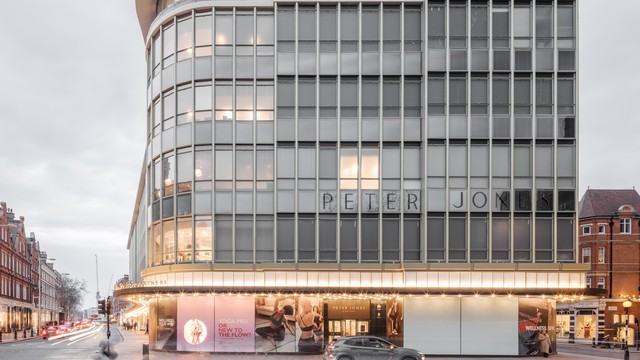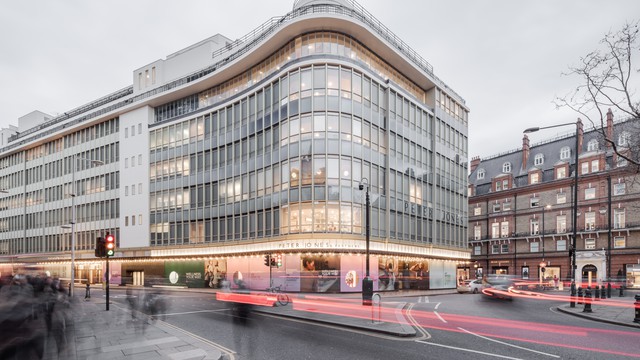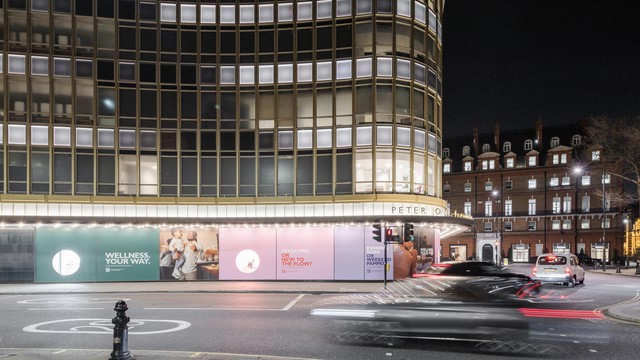Peter Jones & Partners 2021, United Kingdom, London
Media facade for a historic retail building





The media façade of the Peter Jones department store in London revitalises the historic building while preserving its architectural heritage. It is a reinterpretation of an unrealised idea from the original architectural concept and features kinetic and luminous panels that dynamically change the appearance of the building. The content displayed is inspired and influenced by the atmospheric conditions.
Located on Sloane Square in London, the original C19th brick Peter Jones department store was redeveloped in the 1930s and is a Grade II* listed modernist structure. To revitalise the building while still being respectful of its heritage, we developed a media façade that seamlessly melds into the existing architecture. The concept is based on a historical idea: The original blueprints for the building aspired to accommodate the possibility of urban artistic interventions by changing the colour of the spandrel panels behind the glass facade. It was the vision of John Spedan Lewis, the founder of the John Lewis Partnership, who wanted to find a way that would continually reinvigorate the building by changing its colour to reflect the seasons. Working with this unrealised idea, we developed panels that are both mechanical and luminous, making it possible to dynamically change the appearance of the department store. They are fitted behind the building’s glass façade and feature a kinetic slat system inspired by venetian blinds and an LED backlight. The slats are coated white on one side and grey on the other. During the daytime, a slight rotation of the slats causes a change in the building’s appearance. At dawn and dusk, the LED backlight activates and the rotation of the slats now determines how much light shines outwards. And finally, when night has fallen, only the LEDs are lit. Each of the 133 panels is controlled individually and forms one pixel of the façade. The result is a dynamically changing mosaic animating the façade both day and night. The content shown is based on a real-time system whose parameters are influenced by inputs from a weather station on the roof.
Details
Building or project owner : John Lewis Partnership
Architecture : William Crabtree (original building architect), Sergison Bates architects (renovation)
Project artist/ concept/ design/ planning : iart – studio for media architectures / Sergison Bates architects
Structural engineering : iart – studio for media architectures
Facade design : iart – studio for media architectures / Sergison Bates architects
Facade construction : iart – studio for media architectures
Kinetic engineering : iart – studio for media architectures
Light design : iart – studio for media architectures
Technical layout light : iart – studio for media architectures
Display content/ visuals/ showreel : iart – studio for media architectures
Light hardware (LED hardware) : iart – studio for media architectures
Lighting control software : iart – studio for media architectures
Project co-ordination : iart – studio for media architectures
Interaction design/ programming : iart – studio for media architectures
Pixel or other basic module/ elements : iart – studio for media architectures
Descriptions
Facade type and geometry (structure) : In 1932, John Lewis commissioned the architect William Crabtree to redesign the existing Peter Jones department store. The initial phase of redevelopment, facing Sloane Square, was the first steel-framed, glass-fronted building in Britain and is particularly significant in the history of 20th century British architecture. The panels of the media façade are fitted between the glass spandrel panels and the building structure. Their dimensions are 965 x 1245 x 28 mm. To minimise the impact on the building, we used existing elements of the façade for the cable routing, so that only two perforations had to be made.
Kind of light creation : The panels are equipped with kinetic slats and a large RGBW backlight. Depending on the ambient lighting situation, a change in appearance is created by only the slats (day), an interplay between the slats and the backlight (dawn and dusk), and only the backlight (night).
Resolution and transmitting behaviour : There are 133 panels in total: three rows featuring 42 panels and a fourth row – facing Sloane Square – with 7 panels. Each of the panels is controlled individually. The RGBW backlights handle 60 frames per second of 16 bit RGBW data.
Pixel distance : The pixel distance is approximately 1.3 metres horizontally and 4 metres vertically.
Luminace : The façade was developed to cause as little light pollution as possible. During the day it emits no light at all and at night we use the slats to direct the light downwards towards the street. This keeps the light radiation towards the other buildings and the sky to a minimum. The luminance is <20nits with an angle of 45° towards the street (at night).
Urban situation : The Peter Jones department store is located in London’s Borough of Kensington and Chelsea, on Sloane Square. The media façade spans the curved corner of the building between Sloane Square and King’s Road. It is a busy shopping area consisting of mainly C19th buildings that have shops on the lower floors and apartments above.
Description of showreel : The content is generated by a real-time system whose parameters are influenced by inputs from a weather station on the roof. The so-called Lorenz model - named after the meteorologist Edward Lorenz - is the basis of the system. It serves to illustrate the air pressure and shows circular structures, which form repeating but never identical patterns. To guarantee frequent change, two Lorenz systems are superimposed. This creates a constantly changing visual rhythm. Movement, contrast and brightness of the façade vary. On a hot day with high air pressure, clearer patterns will be visible. On a rainy day, by contrast, the patterns will be more fluid in movement and softer in contrast. On a regular day, the content shown is based on an interplay of different shades of white and grey. This can be adapted for special occasions and seasonal themes.
Participatory architecture & urban interaction
Mediacredits
Maris Mazulis
Maris Mazulis
Maris Mazulis
Maris Mazulis
Maris Mazulis
iart - studio for media architectures, Cultureshock Media
iart - studio for media architectures, Cultureshock Media